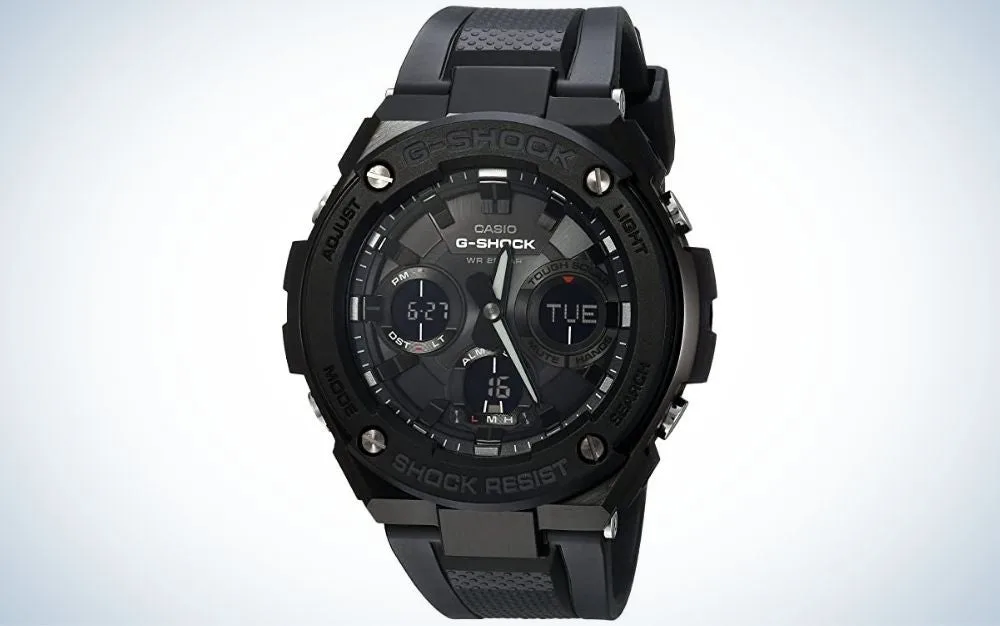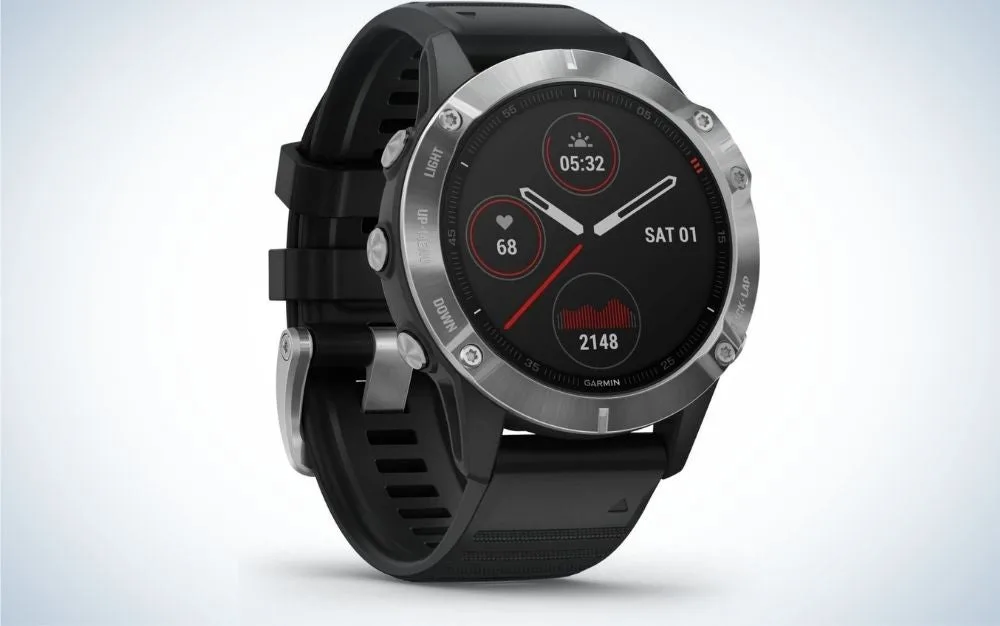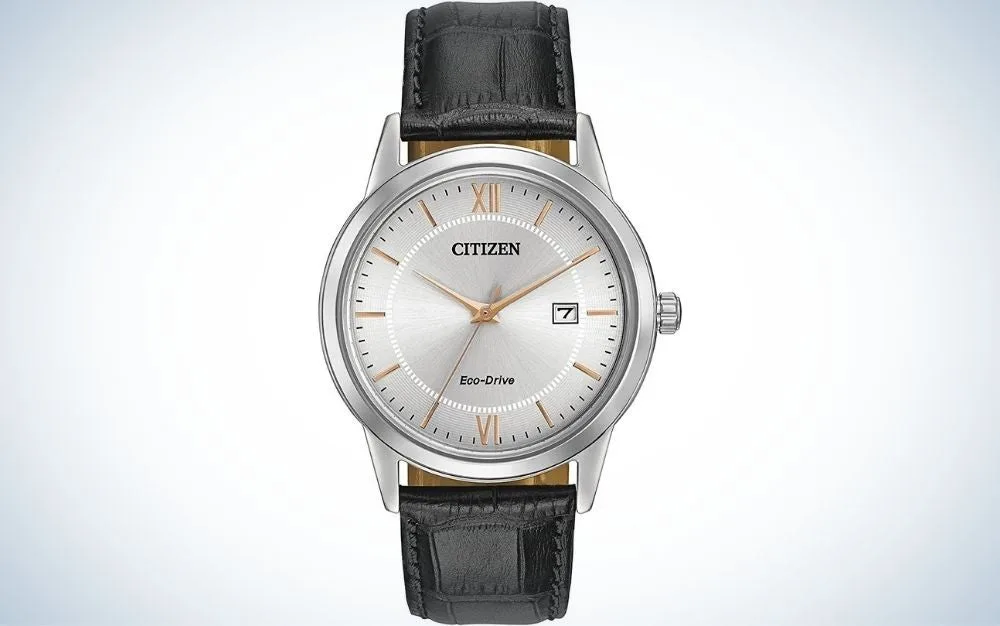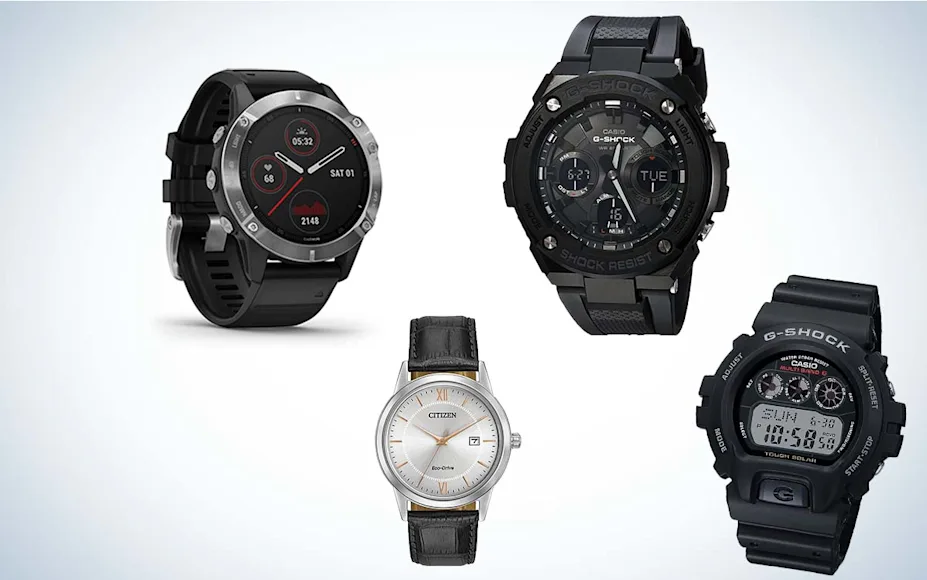_We may earn revenue from the products available on this page and participate in affiliate programs. Learn more ›
_
Best Overall

Casio G-Shock GST-S100G-1BCR
LEARN MORE
Summary
This G-Shock model is absolutely packed with features and is built for the long haul. It is water resistant down to 200-meters and is built with a durable stainless steel case.
Best Outdoor

Garmin Fenix 6
LEARN MORE
Summary
With several different sensors, this watch will provide you with loads of information in an instant, allowing you to adjust and adapt on the fly.
Best Analog

Citizen Corso
LEARN MORE
Summary
With classic lines and looks, the Corso is ready for a night on the town, and you’ll never have to wind it or check the battery to make sure it hasn’t died.
Watches have somewhat fallen out of favor in recent years, due to the prevalence of cell phones, but solar watches can be distinctively useful. Their usefulness, particularly for those of us who venture out beyond the reach of sidewalks on a regular basis, comes in their durability, reliability, and packability. Plus, many watches on the market today do far more than just tell time, and these added features can be very useful. They are smaller and more lightweight than cell phones, plus they require far less energy to operate.
Most solar powered watches are built to last and are rugged enough to wear just about anywhere. As a bonus, they don’t look plain or simply utilitarian and are, instead, decidedly eye-catching. However, the downside is that high-quality solar technology comes at a price. Even the inexpensive end of the spectrum tends to carry a bit heftier price tag than you’ll find with comparable non-solar watches. Here are some of our top choices for the best solar watches on the market.
Best Overall: Casio G-Shock GST-S100G-1BCR
Best Outdoor: Garmin Fenix 6
Best Analog: Citizen Corso
Best Budget: Casio G-Shock GW6900
How We Chose The Best Solar Watches
I’ve been around watches for most of my life. My dad was an avid collector and he passed his hobby on to me. Solar powered watches are still fairly new, in the grand scheme of things, but they’ve been around long enough that we’re able to recognize good quality from mediocre without too much effort.
This is one area where I tend to stick with known brands. This isn’t to suggest that new brands aren’t worth investigating. However, few people can afford to invest in several solar powered watches and thus need to be careful with their purchases. I know going in that Casio, Citizen, and Garmin are going to be high-quality timepieces, both from my own experience as well as their general reputations. What I look for in a solar-powered watch includes:
Power: I want to know how long the watch will run with little or no light. Typically, this won’t be an issue because most of us don’t operate in absolute darkness for long periods of time. However, knowing how well the watch will operate in low light is a good indicator of the quality of the overall package.
Durability: I don’t want something I will feel I need to baby and protect from the environment. While I don’t necessarily expect every watch to be able to handle rock climbing or deep sea diving, a fragile watch won’t be carried nearly as often, which means I’m not going to get my money’s worth out of it.
The Best Solar Watches: Reviews & Recommendations
Best Overall: Casio G-Shock GST-S100G-1BCR
Best Overall

Why It Made the Cut: This G-Shock model is absolutely packed with features and is built for the long haul, though admittedly it is not easy on the wallet.
Key Features
Case diameter: 47mm
Weight: 3.36 ounces
Band length: 9.5 inches
Pros
Water-resistant down to 200 meters.
Day-date-month display.
Durable stainless steel case
Cons
Too thick to wear with a dress shirt.
Casio’s G-Shock line has a longstanding reputation for being overbuilt and rugged enough for just about any adventure. This particular model, the G-Shock GST-100G-1BCR, is jam-packed with bells and whistles that will make any outdoor excursion easier. It is equipped with Layer Guard Structure, combining a solid case with a resin band. The display features white hands against a black background for easy visibility. There are two lights available, one for the face and one that illuminates the LED displays.
A hand shift feature temporarily swings the hands out of the way when you need to view the digital readouts. There is a stopwatch with elapsed time, split time, and 1st/2nd place times, as well as five different daily alarms that can be set. It also has a countdown timer for up to 100 minutes in one-second increments.
When the watch is left in the dark, it will enter Power Save mode automatically, blanking the display to conserve power. On a full charge, it will run for 19 months in this way. With normal use, it will run up to 8 months without any exposure to light after a full charge.
Best Outdoor: Garmin Fenix 6
Best Outdoor

Why It Made the Cut: With several different sensors, this watch will provide you with loads of information in an instant, allowing you to adjust and adapt on the fly.
Key Features
Case diameter: 47mm
Weight: 2.8 ounces
Display resolution: 260 x 260
Pros
Always on, sunlight readable display
Tracks with multiple global navigation systems
Stainless steel bezel and buttons
Cons
May have more features than you truly need
The Garmin Fenix 6 might be the most fully-loaded of the best solar watches on our list. It tracks a truly remarkable amount of data, all of it available right at your fingertips. You can use it to navigate the outdoors, as it has built-in sensors for a 3-axis compass, gyroscope, and barometric altimeter. Combined with its use of multiple navigation satellite systems, you’ll always know where you are.
It is equipped with heart rate and pulse-oximeter sensors. There are pre-loaded sports apps for activities like trail running, golfing, biking, and many more. Add in a step counter and calorie tracker, too. The Power Manager will give you feedback on how things are operating under current conditions, allowing you to make changes if necessary to extend battery life.
The watch is even equipped with safety features that, when paired with a compatible smartphone, will alert your chosen emergency contacts with your location, should a crisis arise.
Best Analog: Citizen Corso
Best Analog

Why It Made the Cut: With classic lines and looks, the Corso is ready for a night on the town, and you’ll never have to wind it or check the battery to make sure it hasn’t died.
Key Features
Case diameter: 40mm
Weight: 1.6 ounces
Band size: 7 inches
Pros
Stainless steel case with handsome black leather strap
Silver dial with rose gold accents
Water resistant to 30 meters
Cons
Not suitable for outdoor excursions
The Corso might not be the watch you reach for when you’re headed out the door for a week-long trek along the Appalachian Trail, but it’ll look darn good on your wrist as you take your significant other out to dinner and dancing. It is a slim watch. The case is a mere nine millimeters thick, and it weighs less than two ounces.
It is equipped with Casio’s Eco-Drive, which powers the watch using absolutely any available illumination, from sunlight to firelight. No matter where you go, the watch will be soaking up the light and keeping the hands moving.
The quartz movement is nearly silent, so if you work in a quiet office the noise won’t be distracting. The 40mm wide case is a bit large and thus this might not be the best choice if you have slim wrists. But it is definitely one of the nicest-looking solar watches on the market today. Coupled with the black leather band, it works with just about any outfit.
Best Budget: Casio G-Shock GW6900
Best Budget

Why It Made the Cut: Atomic timekeeping combined with several useful features and the heavy-duty build G-Shock is known for, all at a sub-$100 price tag make this one a true winner.
Key Features
Case diameter: 41mm
Weight: 2.2 ounces
Water-resistant to 200 meters
Pros
Shock-resistant with LED backlight
Silicone band with buckle closure
Charges with any light source
Cons
Even the budget price might be a bit hefty
The G-Shock GW6900 is the second Casio G-Shock solar watch on our list, a testament to these well-known adventure watches. This entire line of watches is designed for heavy use in challenging environments, and the GW6900 is a great entry-level model. It has a day, date, time display. There are up to four daily alarms, plus one with snooze. The auto calendar is programmed through the year 2099.
The stopwatch feature can do elapsed time as well as split time. There is a countdown timer that can be programmed for up to 24 hours. The watch will operate for about 9 months with normal use on one full charge. It will also run for 26 months on power save mode. You can take it anywhere as it is water-resistant down to a full 200 meters.
A Solar Atomic Timekeeping system keeps the watch running with extreme accuracy, yet with no maintenance on your end. Just expose it to light now and again and you’re good to go.
What to Consider When Choosing a Solar Watch
The beauty of a solar watch is that it never needs winding and likely won’t need a battery change for a couple of decades or more. The use of the term solar is actually a bit of a misnomer as these watches absorb light energy from virtually any source and convert it to power. Depending on the model, it can hold a charge for several months. In this way, they are similar to the best solar generators
on the market, as the batteries are made to hold a charge for months on end without degradation. As with any gear purchase, but especially one that carries a significant investment of funds, there are a few things to bear in mind as you shop around for a solar powered watch.
Size
As a general rule of thumb, the watch case, which is what we call the part of the watch that holds the face and inner workings, should not extend beyond the sides of your wrist. If it does, not only will it feel awkward and clumsy, it will look very odd. The band should be snug, but not so tight that it leaves impressions on your skin when you remove it. Consider the weight of the watch as well. You don’t want it to feel as though you’ve strapped a boat anchor to your wrist. A watch that’s uncomfortable to wear for long periods of time will end up being left at home, which defeats the entire purpose of buying it.
Features
Every watch tells time, but what other features do you want or need? If you’re going to be carrying a watch no matter what, it makes sense to try to get as much use out of it as possible. A stopwatch or timer can be nice when you need to time how long to let food rehydrate at the campsite. A barometer can give you insight regarding upcoming weather changes. Some way to illuminate the watch face at night is always desirable. There are some solar watches that will track your body temperature, heart rate, and more, if that’s the route you want to go. Choose a watch that will do everything you need from it. That said, don’t feel like you need to pop for all sorts of bells and whistles if it is likely that they’ll go unused. Sure, it is better to have them and not need them than to need them and not have them. But, the extra features come at a price.
Budget
When we get right down to it, this will probably dictate your final decision more than anything else. What we want in a watch and what we can actually afford in a watch can be two different things. Sometimes, compromises need to be made. That said, as with many things in life, you usually get what you pay for. It is always better to pay a little more upfront and get something that will last than to skimp out on the initial purchase, but then have to shell out even more money just a bit down the road to replace it when it breaks.
FAQs
Q: Can you get an atomic solar-powered watch?
Yes, there are several atomic solar-powered watches available. What happens with these models is that they receive a signal that is sent out by the U.S. Atomic Clock in Colorado
, the general standard of timekeeping which uses some high-level science to measure time through atoms. The watch adjusts its time to be in sync with the Atomic Clock. The transmitter has a range of more than 1,800 miles, so the signal will be received just about anywhere in the continental United States.
Q: Do solar-powered watches last forever?
It isn’t fair to say that solar-powered watches last forever. Let’s be realistic, nothing truly lasts that long, no matter how well made it is. Anything with moving parts will eventually break down, given enough time. However, many solar-powered watches will last for many, many years without any trouble at all. Most are designed to go for several months without any light at all. Even if the watch exhausts its power reserve, exposing it to light again should eventually bring it back to life.
Q: How much does a solar watch cost?
Solar watches cost a bit more than their non-solar counterparts. There’s just no way around that, due to the higher-end technology needed to provide the charging capability. However, most solar-powered watches are also very well-built, owing to the attention to detail needed to ensure the solar elements work properly. As a practical matter, if you can find a solar-powered watch that’s produced by a well-known and reliable company with a price tag that’s under $100 or so, consider that a win.
Final Thoughts on the Best Solar Watches
At the end of the day, while more and more people are turning to smartphones to be their primary timekeeping gear, there’s still something to be said for a great watch. They’re practical and will always have a place in the well-dressed ensemble. A solar watch adds even greater versatility to the mix. If you’re headed out into the field, read our article on the best solar chargers, and you’ll be ready for any camping, backpacking, or backcountry adventure.
Why Trust Us
For more than 125 years, Field & Stream has been providing readers with honest and authentic coverage of outdoor gear. Our writers and editors eat, sleep, and breathe the outdoors, and that passion comes through in our product reviews. You can count on F&S to keep you up to date on the best new gear. And when we write about a product—whether it’s a bass lure or a backpack—we cover the good and the bad, so you know exactly what to expect before you decide to make a purchase.






